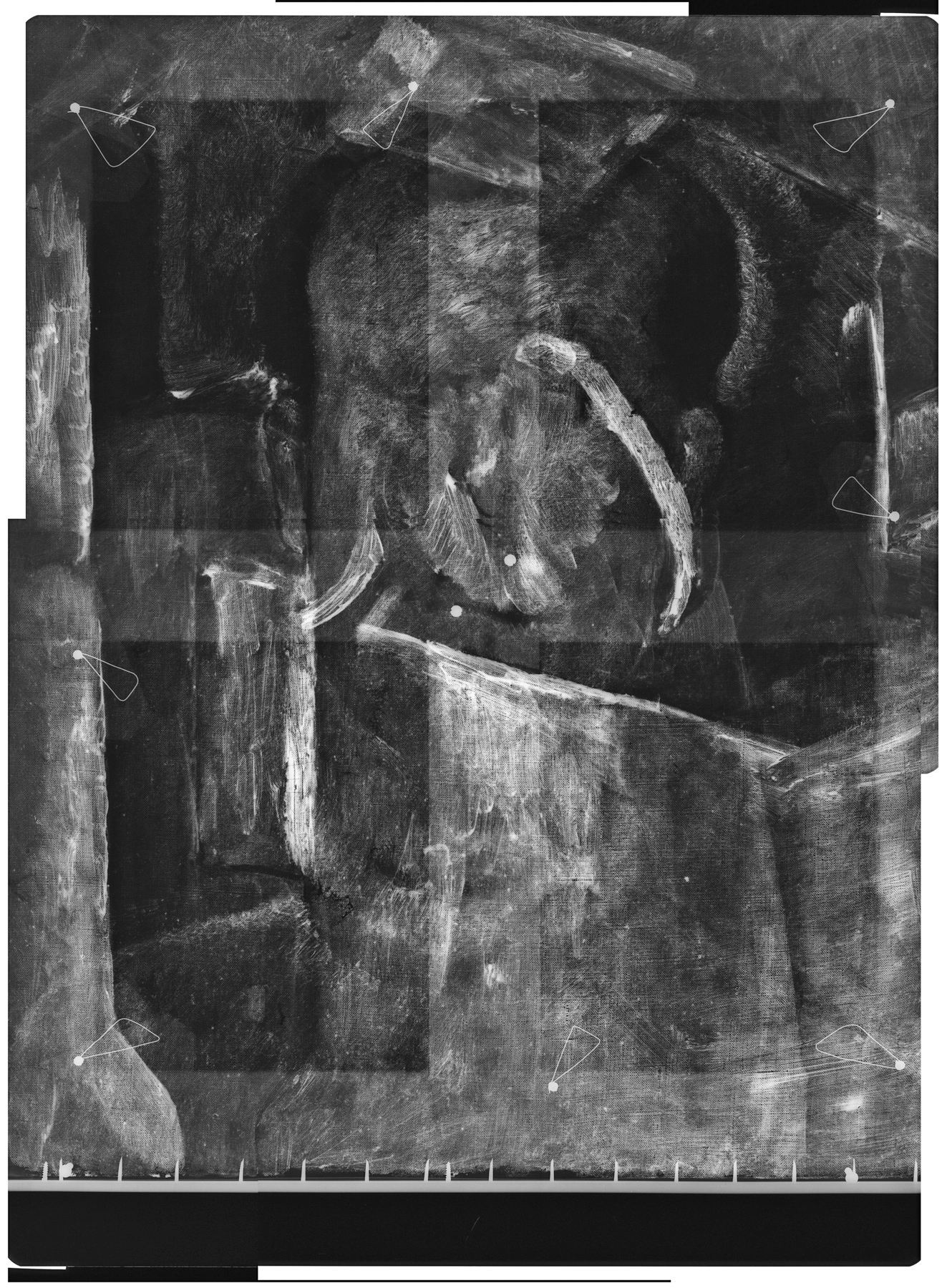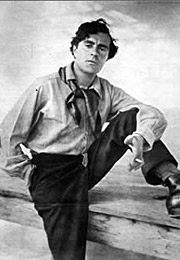


Oil on canvas
54.6 x 45.7 cm. (21 1/2 x 18 in.)
frame: 85.4 x 76.5 x 7.5 cm. (33 5/8 x 30 1/8 x 2 15/16 in.)
L.1988.62.19
Signed lower right: MODIGLIANI
Inscribed across the top: INDE[ ]BAUM
Acquired from the artist by Léon Indenbaum (1890–1981), Paris, 1916; [sold to Georges Chéron (d. 1931), Paris, ca. 1916]. Sold at auction, Hôtel Drouot, 1 July 1937, lot 151. [Victor Raykis, Galerie Zak, Paris]; sold to Henry Pearlman, by 1949; Henry and Rose Pearlman Foundation, after 1974.
Born in Vilnius and educated in Ukrainian art schools, the sculptor Leon Indenbaum (1890-1980) came to Paris in 1911 and probably met Modigliani in the artistic circles of Montparnasse. Both men had studios at various times between 1911 and 1919 in the Cité Falguière, a cul-de-sac off Rue Falguière, named after the nineteenth-century painter and sculptor. Indenbaum would be nearly forgotten today were it not for impressive portraits of him by his friends Modigliani and the Mexican painter Diego Rivera.
According to the Russian sculptor Léon Indenbaum, Modigliani asked to paint his portrait and inquired whether he had painting materials at his apartment. Modigliani painted diligently during three sittings and, despite Indenbaum’s offer to pay, insisted that the portrait was a gift. An inscribed name is included, as on other portraits of Modigliani’s friends who were artists and dealers, suggesting that this was part of a series intended as repayment for material help and friendship. Modigliani’s portraits were also a means of immortalizing the foreigners who, like himself, came to Montparnasse to share in the heady enterprise of creating a new, modernist art.
An x-ray taken on Aug 19, 2011 shows an underlying design unrelated to the portrait of Indenbaum, perhaps the still life that Henry Pearlman describes in his “Reminiscences.”

One night, Modigliani, while rather drunk, saw [Leon] Indenbaum, [the French-Russian sculptor] at a cafe and said he would like to paint his portrait, if Indenbaum would…
After…I purchased [several] Soutine landscapes [I] read all I could about his life and his fellow artists—and soon added a portrait by his best friend, Amedeo Modigliani. The portrait was of Leon Indenbaum, the French-Russian sculptor. I had become good friends with a Parisian dealer on the Left Bank, and one day he sent me a photograph of this portrait. I immediately cabled him to reserve it, as I was leaving a few days later for Amsterdam where I was to spend three days before continuing on to Paris. However, about a half hour before the ship made its stop at Le Havre, I suddenly decided that I just couldn’t wait the week’s time it would take to travel through the Low Countries before reaching Paris. So I left the boat at Le Havre, and telephoned my dealer friend. Only when he told me he had physical possession of the portrait did I relax. Several days later I had the pleasure of meeting the sitter, Leon Indenbaum, who was now close to sixty and very happy to see the portrait again. He hadn’t seen it for some twenty years. He excitedly explained how it came about.
One night, Modigliani, while rather drunk, saw Indenbaum, at a cafe and said he would like to paint his portrait, if Indenbaum would furnish a canvas and an easel to work on. The following morning at nine, Modigliani arrived, spruced up and ready to get to work. Indenbaum had various canvases of paintings by contemporary artists at his atelier. They had been returned, unsold and unclaimed, from a sale for a charitable fund. After turning down several of these canvases because he thought the paintings were too good to spoil, Modigliani found a still-life that he thought could be sacrificed, so he scraped off the heavy paint and commenced.
After three morning sittings of about four hours each, the portrait was finished, and presented to Indenbaum. On looking at it carefully one can see the table and bottle that were part of the original still-life. Several weeks later, Indenbaum, being short of money, sold his portrait for forty francs (eight dollars). When he finally explained to Modigliani that he was forced to sell it, Modigliani said, “That’s all right, I’ll do it again.” However, this never happened.

Amedeo Modigliani (1884-1920)
Modigliani lived a much-fabled life among the international avant-garde circles in early 20th-century Paris. Although he died at the age of thirty-five, Modigliani was a prolific artist, best known for his uniquely stylized paintings and drawings of friends, lovers, fellow artists, and literary figures. As a group, these works form an articulate portrait of the avant-garde centered around Montmartre at the time.
Modigliani was born in Livorno, Italy, to a middle-class Jewish family. He suffered serious illness during his youth, contracting pleurisy, which developed into tuberculosis. From his early teens he resolved to become an artist, and in 1898 he began to study with local plein air painter Guglielmo Micheli, who stressed working directly from nature. Modigliani was exposed to a wide variety of Italian art over the course of travels through his home country and received formal training in Florence (1902), followed by Venice. In January 1906, Modigliani moved to Paris, where he settled, first in Montmartre and later in Montparnasse, and attended the Académie Colarossi. Among the international coterie of young artists, Modigliani stood out in particular for his combination of personal elegance, intellectual prowess, and frail health. He experimented with different styles and influences, including the work of Henri de Toulouse-Lautrec, Picasso’s blue period, and the late portraits of Paul Cézanne.
Modigliani first turned to sculpture in 1902, and the medium became his primary focus from 1909 to 1914. He was inspired in part by meeting Constantin Brancusi, whose stylized sculptural forms, devotion to direct carving, and fierce independence all had an impact on Modigliani. He created a body of about twenty-five carved stone sculptures that focused on abstracted female heads, which vividly melded the influence of African sculpture with strains of Egyptian, Cycladic, Greek, Romanesque, and Gothic styles. Conceiving of these works as a series, he exhibited seven heads together in 1912 at the Salon d’Automne, under the title Têtes, ensemble décoratif.
Apparently due to health concerns and other practicalities, Modigliani ceased work on sculpture around 1914 and turned his focus to drawing and painting, in which the influence of his sculptural work remained indelible. He made a series of overtly erotic contemporary nudes, although portraiture was his dominant subject. Modigliani’s portraits combine abstraction and elements of caricature; his stylized faces and bodies often are surprisingly revealing in their degree of penetrating observation and psychological subtleties. His portraits captured many leading figures in the artistic and literary avant-garde, among them Jacques Lipchitz, Pablo Picasso, Diego Rivera, Chaïm Soutine, Jean Cocteau, and Max Jacob. Modigliani’s life was cut short by tubercular meningitis, and his demise was hastened by his abundant use of drugs and alcohol.